As we age, maintaining strength and flexibility in our arms becomes increasingly important for our overall well-being and daily activities.
A strong and mobile upper body can help seniors maintain their independence, perform everyday tasks with ease, and enjoy a higher quality of life. In this guide, we present 15 arm workouts for seniors who want toned arm muscles.
These exercises are designed to be safe, low-impact, and suitable for various fitness levels. Whether you’re looking to improve your arm strength, prevent age-related muscle loss, or simply stay active and feel more confident in your movements, these workouts are here to help.
Remember, it’s never too late to start working on your arm strength. Regular exercise can enhance your physical health, boost your mood, and help you lead a more fulfilling and active life.
So, let’s get started on the journey to stronger, more resilient arms, allowing you to age gracefully and with confidence.
15 Arm Workout for Seniors
Here are 15 arm workouts designed for seniors to help maintain strength and mobility:
1. Seated Arm Circles
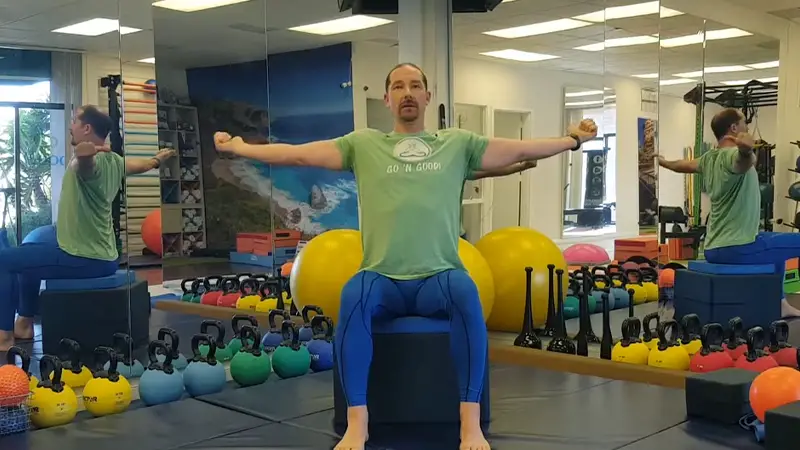
Sit upright in a chair and extend your arms to the sides. Make small circles with your arms, first in one direction, then reverse. Seated arm circles improve shoulder mobility and reduce stiffness.
2. Bicep Curls
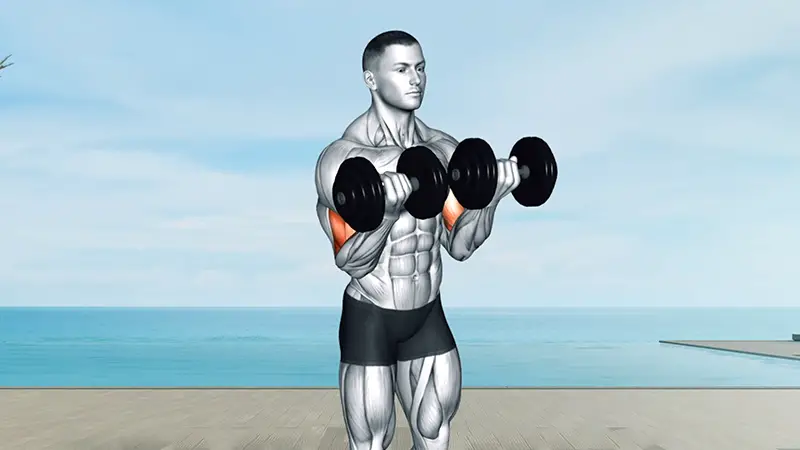
Sit in a chair with a light dumbbell in each hand (or use water bottles). With your palms facing upward, bend your elbows and curl the weights towards your shoulders.
Bicep curls strengthen the biceps and forearms, aiding in daily tasks that require arm strength.
3. Tricep Dips
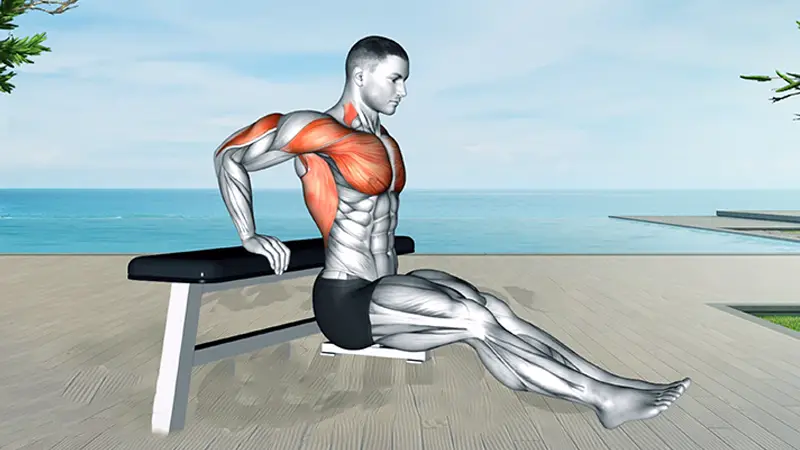
Sit on the edge of a sturdy chair, place your hands on the seat beside you, slide your hips off the chair, and lower your body before returning to the starting position. Tricep dips target the triceps and enhance arm strength.
4. Seated Hammer Curls
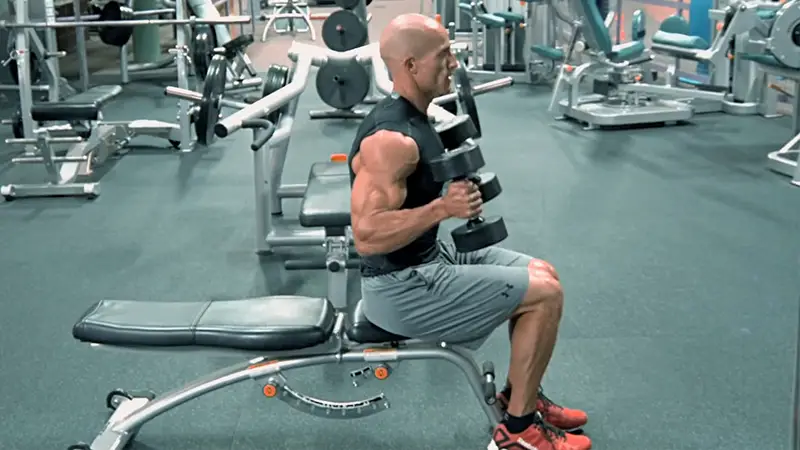
Sit upright with a dumbbell in each hand, palms facing your torso. Bend your elbows and curl the weights upward. Hammer curls work the biceps and forearms.
5. Wall Push-Ups
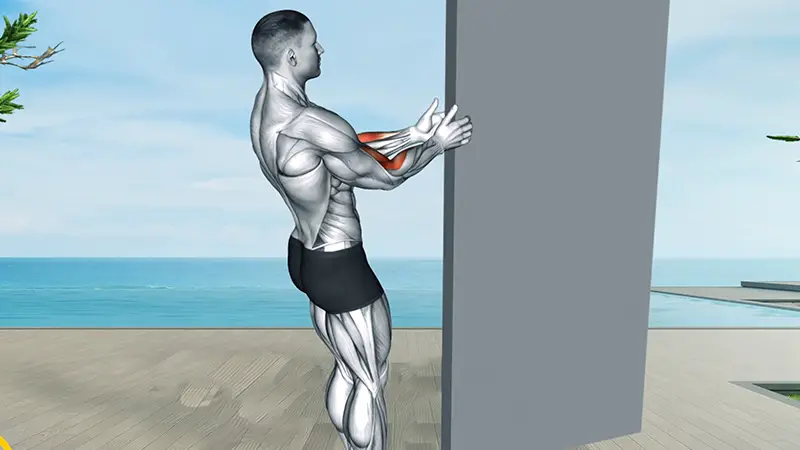
Stand facing a wall with your hands at shoulder height. Perform push-ups against the wall. This exercise targets the chest, shoulders, and triceps, providing upper body strength without the intensity of traditional floor push-ups.
6. Overhead Arm Raises
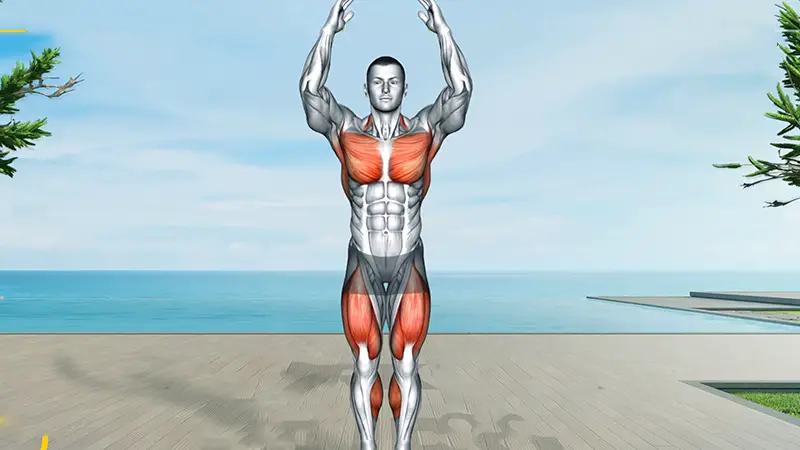
Sit upright in a chair with a light dumbbell in each hand (or use water bottles). With your arms extended, lift the weights overhead. Overhead arm raises strengthen the shoulder muscles.
7. Resistance Band Rows

Sit in a chair and hold a resistance band with both hands, palms facing inward. Simulate a rowing motion by pulling the band towards your waist. This exercise targets the upper back and shoulders, promoting better posture and reducing upper body discomfort.
8. Seated Shoulder Shrugs

Sit tall and lift your shoulders towards your ears, then lower them. Shoulder shrugs relieve tension in the upper back and neck, increasing shoulder mobility.
9. Arm Extensions

Sit on a chair with your back straight and hold a light dumbbell in each hand. Extend your arms forward, then bring them back to your sides. Arm extensions target the shoulder and upper arm muscles.
10. Resistance Band Bicep Curls

Sit in a chair and step on a resistance band, holding one end in each hand. Perform bicep curls by bending and extending your elbows. Resistance band bicep curls strengthen the biceps and forearms.
11. Seated Reverse Flyes

Sit with a dumbbell in each hand. Lean forward slightly and extend your arms out to the sides. Bring your arms back to the center. Seated reverse flies target the upper back and shoulders, enhancing upper body strength.
12. Seated Hammer Raises

Sit with a dumbbell in each hand, palms facing your torso. Lift the weights to shoulder height, then lower them. Hammer raises work the front and side deltoid muscles.
13. Wrist Curls

Sit with your forearm resting on a table and hold a lightweight with your palm facing upward. Curl the weight upward, then lower it. Wrist curls strengthen the forearm muscles, aiding in grip strength.
14. Wrist Extensions

Sit with your forearm resting on a table and hold a lightweight with your palm facing downward. Curl the weight upward, then lower it. Wrist extensions work the forearm muscles, enhancing wrist strength and flexibility.
15. Seated Arm Twists

Sit with your back straight, extend your arms to the sides, and twist your wrists in one direction and then the other. Seated arm twists reduce wrist stiffness and promote flexibility.
These arm workouts for seniors can help maintain arm strength, flexibility, and functional mobility, contributing to overall well-being and independence.
It’s essential to start with appropriate weights and repetitions, gradually increasing intensity under the guidance of a fitness professional to avoid strain or injury.
Always consult with a healthcare provider before starting a new exercise program to ensure these exercises are suitable for your individual needs and health status.
How Can I Strengthen My Elderly Arms?
Strengthening the arms of elderly individuals is essential for maintaining independence, improving quality of life, and reducing the risk of injuries related to weakened upper body strength.
Age-related muscle loss, known as sarcopenia, can lead to reduced mobility and a decline in functional abilities. Fortunately, there are various safe and effective ways for seniors to strengthen their arms.
Let’s explore strategies and exercises to help elderly individuals enhance their arm strength.
Consult a Healthcare Professional
Before embarking on any exercise regimen, it’s crucial for seniors, especially those with pre-existing medical conditions, to consult with a healthcare professional. They can provide personalized advice and guidance tailored to individual health needs and restrictions.
Resistance Training
Incorporating resistance training into an exercise routine is one of the most effective ways to build arm strength.
Resistance bands, dumbbells, and even household items like water bottles can be used to create resistance during exercises. Here are a few resistance exercises to consider.
Try bicep curls and hold a weight in each hand (or use resistance bands), and with your palms facing forward, curl your hands toward your shoulders. Perform 2-3 sets of 10-12 repetitions.
For tricep dips, use a sturdy chair, sit at the edge, and place your hands on the chair with your fingers facing forward. Lower your body and then push up, working your triceps. Aim for 2-3 sets of 10-12 repetitions.
To do resistance band pull-apart, stand on a resistance band and hold both ends, then pull your arms apart, engaging your shoulder and back muscles. Complete 2-3 sets of 10-12 repetitions.
Bodyweight Exercises
For seniors who may not have access to weights or resistance bands, bodyweight exercises can be highly effective for arm strengthening. Some key bodyweight exercises include wall push-ups and chair push-ups.
For wall push-ups sit a few feet from a wall, place your hands on the wall at shoulder height, and perform push-ups. Start with sets of 5-10 repetitions and gradually increase.
To perform chair push-ups, sit at the edge of a sturdy chair with your hands on the chair, and perform push-ups. Begin with 5-10 repetitions and progress from there.
Range of Motion Exercises
Maintaining flexibility in the arms is crucial for everyday activities. Simple range of motion exercises can help keep the arms supple.
Try arm circles where you extend your arms straight out to the sides and make circular motions with your arms, both forward and backward. For shoulder tolls, you can roll your shoulders forward and backward to relieve tension and improve mobility.
Yoga, Stretching, and Tai Chi
Yoga and Tai Chi are excellent options for seniors as they combine strength-building exercises with flexibility and balance. These low-impact practices can help enhance arm strength while also promoting overall well-being.
Incorporate gentle arm stretches into your daily routine to maintain flexibility. Stretching can be especially beneficial for relieving muscle tension and improving circulation.
Water Aerobics
Water aerobics is a low-impact exercise that provides resistance and supports the body. Many senior centers and community pools offer water aerobics classes, which can help strengthen the arms and increase cardiovascular fitness.
Stay Hydrated and Eat a Balanced Diet
Proper nutrition and hydration are essential for muscle health. Ensure you are consuming enough protein and maintaining good hydration levels. A well-balanced diet can provide the necessary nutrients to support muscle growth and recovery.
Rest and Recovery
Allow your body time to rest and recover between workouts. Adequate rest is vital for muscle repair and growth. Overexertion can lead to injury, so listen to your body and adjust your routine accordingly.
Consistency is crucial in any fitness routine. Aim to exercise regularly, even if it’s just a few times a week. Gradually increase the intensity and duration of your workouts as you become more comfortable and stronger.
Safety First
Safety should always be a top priority. Ensure that the exercise environment is free from hazards, and consider exercising with a partner, especially if you have balance or mobility issues.
Keep a record of your workouts and monitor your progress over time. Tracking your improvements can be motivating and help you set achievable goals.
In summary, strengthening elderly arms is not only achievable but also highly beneficial for overall health and quality of life.
A combination of resistance training, bodyweight exercises, range of motion exercises, and other low-impact activities can help build and maintain arm strength.
Remember that it’s essential to consult with a healthcare professional before starting a new exercise regimen, and always prioritize safety and gradual progress.
By following these guidelines, seniors can enjoy the benefits of stronger arms, improved independence, and a higher quality of life.
FAQs
Is it safe for seniors to engage in arm-toning exercises?
Yes, it is generally safe for seniors to participate in arm-toning exercises. However, it’s crucial to consult with a healthcare professional or a fitness expert before starting any new exercise program, especially if you have pre-existing health conditions or concerns.
Can I use resistance bands even if I’ve never used them before?
Yes, resistance bands are a great choice for seniors, even if you’re new to using them. They come in various resistance levels, allowing you to start with lighter resistance and gradually increase it as you become more comfortable and stronger.
How long will it take to see noticeable results in my arm tone?
The time it takes to see noticeable results in arm tone can vary from person to person. Factors such as your starting fitness level, the frequency of exercise, and your diet can all impact the timeline.
Can I tone my arms without lifting heavy weights?
Absolutely! You don’t necessarily need to lift heavy weights to tone your arms. Bodyweight exercises, resistance bands, and light dumbbells can all effectively strengthen and tone your arms.
How can I prevent sagging skin on my arms while toning them?
While exercise can help improve muscle tone, it may not address skin elasticity directly. To minimize sagging skin, you can stay well-hydrated, as dehydration can affect skin elasticity. Use moisturizers to keep your skin hydrated and supple.
Conclusion
Strengthening elderly arms is not only achievable but also highly beneficial for overall health and quality of life.
A combination of resistance training, bodyweight exercises, range of motion exercises, and other low-impact activities can help build and maintain arm strength.
Remember that it’s essential to consult with a healthcare professional before starting a new exercise regimen, and always prioritize safety and gradual progress.
By following these guidelines, seniors can enjoy the benefits of stronger arms, improved independence, and a higher quality of life. Incorporating these 15 arm workouts into your daily routine can make a world of difference in your life as a senior.
The benefits of improved arm strength and flexibility extend far beyond just physical health; they also contribute to mental and emotional well-being. As you engage in these exercises, remember to prioritize safety and listen to your body.
I am a fitness instructor and I have been in the industry for 9 years. I have a passion for health and fitness.
I am a fitness instructor with over 9 years of experience in the industry. My passion is health and fitness and I would love to share my knowledge with you!